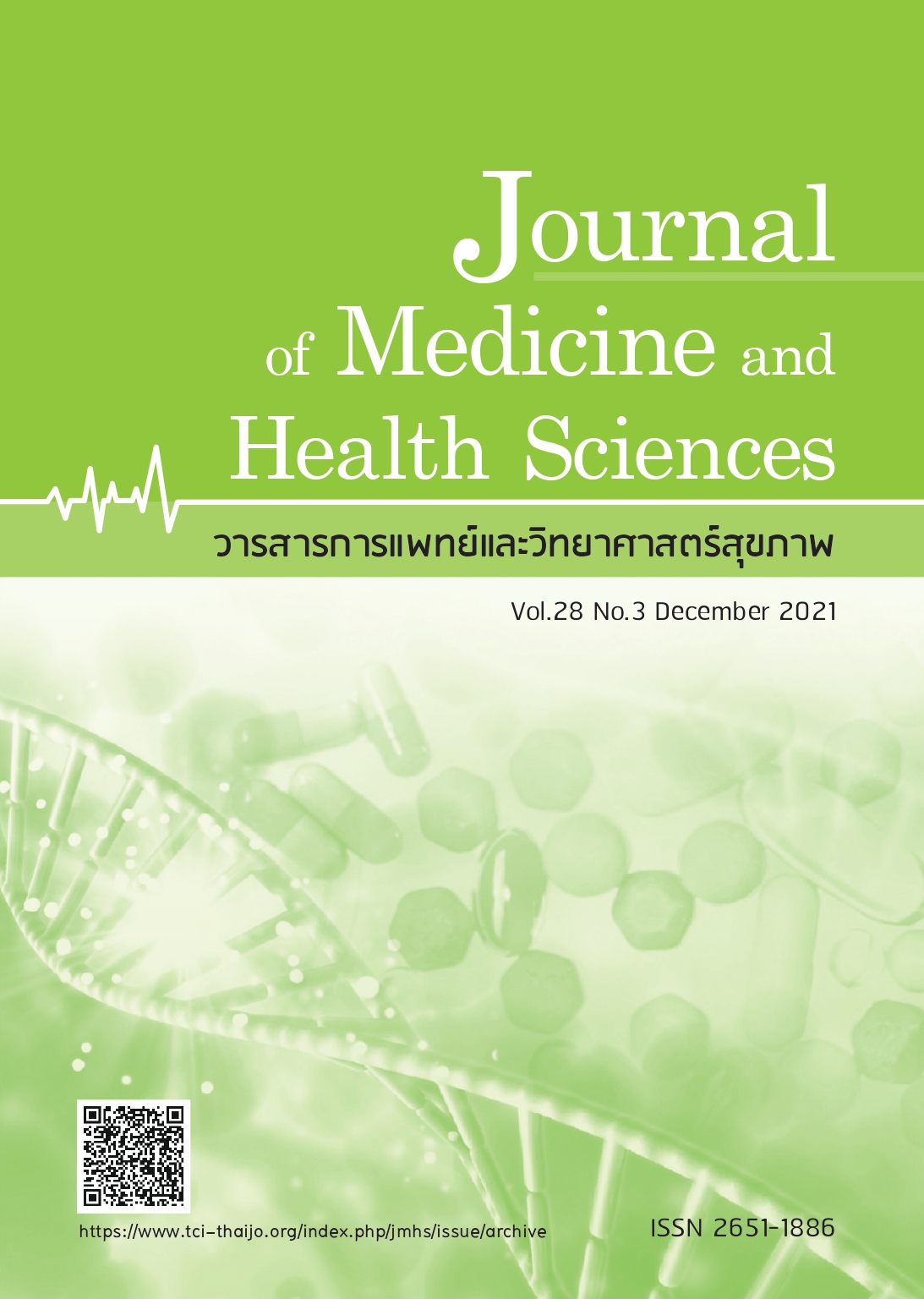Factors associated with cervical cancer screening among women aged 30-60 years in the Taktok sub-district health promotion hospital in Tak Province
Keywords:
screening, cervical cancer, barrier perceptionAbstract
Abstract
Cervical cancer is the second-most common cancer among women worldwide. An early cervical cancer screening is essential to help prevent and control cervical cancer. This cross-sectional analytical study aims to investigate the factors related to cervical cancer screening among women aged 30-60 years and in the care of the Taktok Sub-district Health Promotion Hospital in the Bantak district of Tak province. The data were collected by using questionnaires from the sample group of 378 participants. The associations between the factors related to cervical cancer screening were analyzed through multiple logistic regression. The results showed that the factors associated with the cervical cancer screening consisted of marital status (adjusted OR = 3.37, 95%CI: 2.03-5.60, p<0.001); history of previous contraception usage (adjusted OR = 1.92, 95%CI:1.20-3.07, p=0.006); advice from physicians (adjusted OR = 5.89, 95%CI: 2.44-14.23, p<0.001); a moderate level of barrier perception (adjusted OR = 10.03, 95%CI: 1.24-81.35, p=0.031); and a low level of barrier perception (adjusted OR = 32.11, 95%CI: 3.97-259.92, p=0.001). In conclusion, the factors associated with cervical cancer screening are as follows: marital status; previous contraception; advice from physicians; and low and moderate levels of barrier perception. Therefore, the program design for a cervical cancer screening program should emphasize such factors in order to increase the coverage of cervical cancer screening.
References
2. World Health Organization. WHO guidance note: comprehensive cervical cancer prevention and control: a healthier future for girls and women; 2013. [cited 2018 Dec 17]. Available from:http://who.int/ reproductivehealth/publications/ cancers/9789241505147/en.
3. Bray F, Me FJ, Soerjomataram I, et al. Global cancer statistics 2018: Globocan estimates of incidence and mortality worldwide for 36 cancers in 185 countries. Care Cancer J Clin 2018.68:394-424.
4. WorldHealthOrganization.Comprehensive cervical cancer control: A guide to essential practice 2nd ed; 2014. [cited 2018 Dec 17]. Available from: https://apps.who.
int/iris/handle/10665/144785.
5. National Cancer Institute. Cancer in Thailand. X(2016-2018): 2021. p.9-71.
6. Ministry of Health. Comprehensive cervical cancer control : A guide to essential practice. 2015. p.83-4.
7. Tak Provincial Public Health Office. Cervical cancer morbidity rate, Regional health 2, Tak province, year 2016-2018. [cited 2019 Jan 27]. Available from: https://tak.hdc.moph.go.th/hdc/reports/ report.php?source=formated/ncd.php&cat_id=59acae7a68f02c8e2c0cb88dfc6df3b3&id=f3a9cabcd1b83af2ad8d8db6d9b6735c.
8. Pittayawechwiwat W. Abnormal pap smearscreening and retrieval. Buddhachinaraj Med J 2008;25:2-4.
9. Laohutanon P, Chaiweerawattana A, Imsamran W. Guidelines for screening, diagnosing and treating cervical cancer. Bangkok: Kositpress;2013.
10. Tak Provincial Health Office. Cervical cancer screening rate in women aged 30-60 years, Health region 2, Tak province. HDC data, [cited 2019 Jan 27].
11. Budkaew J, Chumworathay B. Factors associated with decisions to attend cervical cancer screening among women aged 30-60 years in Chatapadung
Contracting Medical Unit, Thailand. Asian Pac J Cancer Prev 2014;15:4903-07.
12. Al-Naggar RA, Low WY, Isa ZM. Knowledge and barriers towards cervical cancer screening among young women in Malaysia. Asian Pac J Cancer Prev 2010;11:867-73.
13. Glanz Karen, Rimer Barbara K, Viswanath K. Health behavior and health education. 4th ed; 2008.
14. Rajkumar R. Community Based Cancer Screening_The 12 “I” s Strategy for Success. In: Rajkumar R, editors. INTECH d.o.o.2012; Available from: https://www.
intechopen.com/books/951. London: Intech;2012.p.25-38.
15. Wongwatcharanukul L, Promthet S, Bradshaw P, et al. Factors affecting cervical cancer screening uptake by Hmong hilltribe women in Thailand. Asian Pac J Cancer Prev 2014;15:3753-6.
16. Nantachai K, Jirapornkul C, Tangsrithong N, et al. Factors associated with not receiving cervical Cancer screening among Akha hilltribe women, Muang district, Chiangrai province. Srinagarind Med J 2016;31:192-201.
17. Visanuyothin S, Chompikul J, Mongkolchati A. Determinants of cervical cancer screening adherence in urban areas of Nakhonrachasima province, Thailand. JIPH 2015;8:543-52.
18. Nwabichie CC, Manaf RA, Ismail SB. Factors affecting uptake of cervical cancer screening among African women in Klang valley, Malaysia. Asian Pac J cancer Prev
2017;19:825-31.
19. Hsieh FY, Bloch DA, Larsen MD. A simple method of sample size calculation for linear and logistic regression. Statist Med 1998;17:1623-34.
20. Kahesa C, Kjaer S, Mwaiselage J, et al. Determinants of acceptance of cervical cancer screening in Dar es Salaam, Tanzania. BMC Public Health 2012;12:1-8.
21. Nene B, Jayant K, Arrossis S, et al. Determinants of women’s participation in cervicalcancerscreeningtrail,Maharashtra, India. Bulletin of the World Health
Organization 2007;85:264-72.
22. Gan DEH, Dahlui M. Cervical screening uptake and its predictors among rural women in Malaysia. Singapore Med J 2013;54:163-8.
23. C h e s u n A , H a r n c h a r o e n K , Taechaboonsermsak P, et al. Factors related with cervical cancer screening test among Thai Muslim women in Satun
province. Asia J Public Health 2012;3:79-85.
24. Taylor VM, Yasui Y, Burke N, et al. Pap testing adherence among Vietnamese American women. Cancer Epidemiol Biomarkers Prev 2004;4:613-9.
25. Hislop TG, Deschamps M, Teh C, et al. Facilitators and barriers to cervical cancer screening among Chinese Canadian women. Can J Public Health 2003;94:68-73.
26. Lee EE, Fogg L, Menon U. Knowledge and beliefs related to cervical cancer and screening among Korean American women. West J Nurs Res 2008;30:960-74.
27. Boonpongmanee C. Jittanoon P. Predictors of papanicolaou testing in working women in Bangkok, Thailand. Cancer Nurs 2007;30: 384-9.
28. Abdullah F, Aziz NA, Su TT. Factors related to poor practice of pap smear screening among secondary school teacher in Malasia. Asian Pac J cancer Prev 2011;12:
1347-52.



